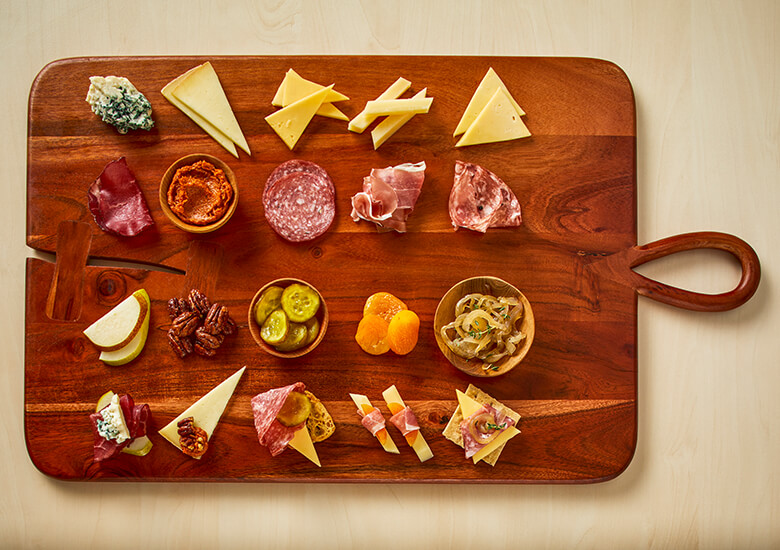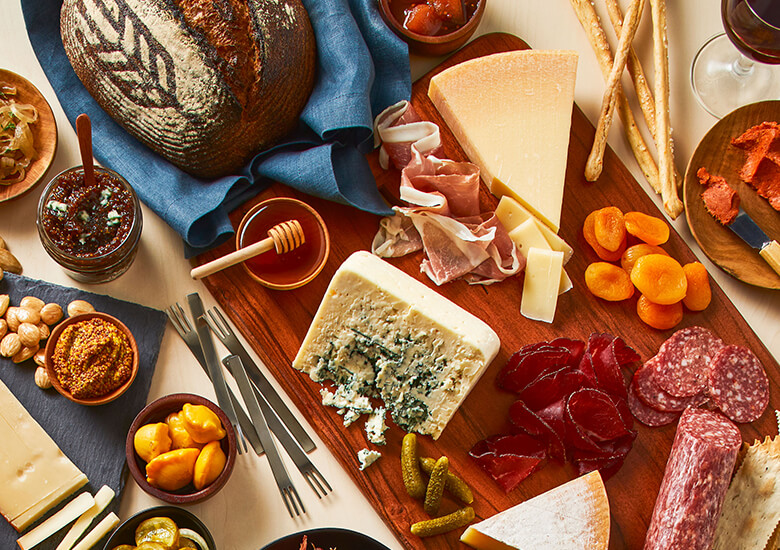A meat and cheese platter is the easiest way to entertain and look like you’ve put in a ton of effort when – spoiler alert – it’s just some basic tricks and knowledge that we’ll teach you right here.
Just like you’d pair wine and cheese, certain meats and cheese complement each other better than others. We’ve put together a comprehensive how-to guide on pairing meat and cheese and setting up the best charcuterie board – ever. Start planning your next party now.
Must-try meat and cheese pairings

We’ve all been there, standing in the grocery store aisle looking at dozens of different salamis and soppressata, while desperately Googling “does prosciutto go with swiss?”
We’re not in the business of cheese discrimination; all cheeses and cured meats are delicious. Nonetheless, it can be overwhelming. Here are a few of our favorite must-try combinations.
Salami and gouda
Salami is a charcuterie crowd-favorite and honestly, you really can’t go wrong with this cheese pairing. Try pairing it with gouda, a semi-hard cheese with roots in the Netherlands. Gouda comes in multiple varieties – aged, smoky, or flavor-infused – to suit whichever mood you’re in. One of our favorites is Marieke® Gouda, which comes in a variety of spicy, sweet, and savory flavors including pepper, paprika, coriander, honey clover, fenugreek, allspice, and onion.
Prosciutto and parmesan
Salty, crumbly parmesan and buttery prosciutto meet in a sensual dance of flavors on your tongue. Prosciutto is an Italian dry-cured ham, often sliced ultra-thin. Both prosciutto and parmesan are typically aged, making them super flavorful and salty-sweet in the best way. You’ll have to excuse us for a moment while we daydream about meat and cheese.
Soppressata and havarti
Soppressata, a dry salami, can be made with both pork or beef. Whichever kind you choose, you can’t go wrong pairing it with havarti, a creamy, semi-soft cheese. Havarti’s supple, buttery taste allows the herbs and spices in the soppressata to shine through while drawing out the nutty, earthy notes of the cheese.
‘Nduja and alpine-style
‘Nduja (“en-doo-yah”) is the element for your charcuterie board that you didn’t know you needed. This soft, spicy pork spread is a trendy Calabrian specialty that’s guaranteed to add a kick to your cheese feast. Alpine-style cheese is the perfect pairing for it. Its creaminess will take the edge off the ‘nduja’s hot red peppers and balance its other flavor components. We’d be remiss if we didn’t mention that ‘ndjua is also the perfect choice to spice up a grilled cheese. Here's our recipe for a delicious 'nduja grilled cheese.
Meat and cheese accompaniments

Pairing meat and cheese is an art form that when properly done, it enhances the flavor, mouthfeel, and experience of each component. However, adding in other accompaniments brings your cheese board to the next level, adding visual interest and drawing out complementary flavors. Try adding sweet, crunchy, and savory elements to your next charcuterie board.
Sweet
Many cheeses have a slight sweetness to them, so pairing them with fruit is a great way to draw out those subtle sweet undertones. Figs are great with parmesan or blue cheese. They’re freshest in June and July, so they make the perfect addition to a summertime picnic or party appetizer. Dried apricots are delicious paired with gouda or cheddar, and as an added bonus, they keep well in your pantry for months, making it a great addition to a hastily-thrown-together, my-in-laws-made-an-unexpected-visit cheese board.) Pears play off feta, and cantaloupe is a great pair with prosciutto.
Crunchy
While you might have some cured meats that are a bit more toothsome, your average cheese board is going to have a lot of similar soft textures. Adding in crunchy accompaniments is a great way to add some more interest and variety. Nuts are a great place to start. Try some pecans with gouda or cashews with blue cheese. Sesame sticks are another way to get some crunch on your plate and are great with an asiago or parmesan.
Savory
Olives bring a savory, salty element that spices up your cheeses. Try Kalamatas with feta for a classic Mediterranean feel or green olives with swiss or gouda. Cranberry chutney hits that sweet-savory balance just right and is particularly festive around the winter holidays. Try it with cheddar and prepare for your socks to be knocked off. Cornichons – French for tiny pickles – are both adorably small and deliciously tart while adding in some much-needed acidity to cut the richness. Try them with emmental and salami. A whole-grain Dijon mustard is a great addition to an aged cheddar.
Charcuterie board tips

The best parties are ones with a big charcuterie board. Whether it’s your first time setting up a cheese platter or you’re a seasoned charcuterie veteran, here are some best practices to keep in mind.
Plan out portions
There’s nothing more tragic than leftover cheese that’s been sitting out slightly too long to salvage. Planning out the right portions for your guests makes sure that no delicious cheese or meat goes to waste.
If cheese is the main event (as it usually is), plan on each guest eating about eight ounces of cheese, or about half a pound. If cheese is the appetizer or dessert, plan on each guest eating two to four ounces of cheese.
Include a variety of textures
Make sure to include cheeses with contrasting flavors and textures: a soft mascarpone and a firm GranQueso®; a mild mozzarella and a full-bodied cheddar blue; a salty feta and a smoky gouda.
Including different types of cheeses keeps guests interested in the platter and ensures that there’s something for everyone.
Try picking out a couple crowd favorites that you know will be satisfying and adding in a more challenging cheese to broaden horizons. For example, we love The Blue Jay, an ultra-creamy blue cheese with juniper berries and Fenugreek gouda.
Practice presentation
Fun fact: We eat with our eyes. You may have picked out the most luscious, creamy, artisanal cheese – but making it look appetizing will actually improve its taste even more. (Seriously, it’s science.) Here are a few quick tips to making an Instagram-worthy charcuterie board:
- Try layering your cheese and meat on a wooden platter for a rustic feel.
- Keep to odd numbers, like five cheeses and three meats, for an aesthetically pleasing arrangement.
- Use accompaniments, like fruits, nuts, and jams to fill in gaps in the board and make it look more abundant. Just make sure there’s enough room for guests to cut the cheeses.
- Cut a few slices of at least one of the cheeses before serving. It sounds counterintuitive, but this keeps the cheese platter from looking too “perfect” and staying untouched. No one wants to be the first person to mess up the gorgeous platter, so cutting off a little cheese makes the cheese board more inviting. Plus, it’s important to sample the cheese. And…maybe sample it again. Just to make sure it’s okay. That’s what being a good host is about, right?
Lucky for you, we have whole blog dedicated to the art of creating a cheese board that will be the envy of all your friends.
Ready to meat your destiny?
Congratulations, Cheese Lover! You’re now a proud graduate of cheese and meat pairing 101 -- fully equipped to masterfully assemble the perfect pairings of meat and cheese. Flex your cheese board muscles with our of our cheese board recipes, like this Summertime Cheese Board or this Sweet and Savory Brunch Cheese Board or pick something else that suits your style from our selection of over 300 handcrafted recipes featuring Wisconsin cheese. Share your creation with us on Instagram or Facebook and become part of the largest cheese community in the world.
FAQs
What is a meat and cheese platter called?
A meat and cheese platter is called a charcuterie board. “Charcuterie” is a French word that refers to cold, cured meats. While a charcuterie board can only be an assembly of cured meats, it typically includes cheeses and accompaniments like fresh fruit, cornichons, and nuts.
How do you style a charcuterie board?
For a rustic charcuterie board, arrange your meat and cheese on a wooden board. Odd numbers are the most aesthetically pleasing, so try out five cheeses and three meats. Folding or rolling your charcuterie slices make them look beautiful while allowing guests to easily grab some servings. Use accompaniments like nuts, dried apricots, fresh figs, olives, and cornichons to fill in gaps on the board and give the appearance of lush abundance.
What cheese goes with prosciutto?
Aged parmesan and prosciutto pair perfectly. Try it with cantaloupe or fresh figs, and maybe a glass or two of prosecco. Don’t forget to send us an invite.
What wine goes with cheese and salami?
If you’re going for a mild brick, white wine like pinot grigio is a great option. For a stronger cheese like aged gouda, pick out a red wine like cabernet sauvignon. Wine and cheese pairing is a whole art form – we’ve put together the top tips.
